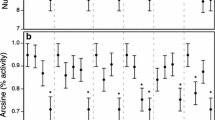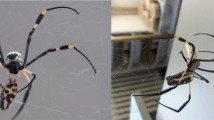Summary
The contribution of prey-capture speed to toads' ability to ingest chemically protected prey is evaluated: first, by measuring the speed of toads ingesting palatable prey for comparison with reaction times for prey defenses, and second, by analyzing encounters between toads and bombardier beetles — insects with a quick and potent chemical defense.
-
1.a.
Analysis of filmed (64 fps) prey-capture sequences reveals that the rapid tongue flip is preceded by a slower forward lunge of the entire body and followed by a still slower ingestion of retrieved prey (Fig. 1, Table 1). Only the tongue flip, which establishes contact with the prey and retrieves it into the toad's mouth, requires less time than latencies typically reported for invertebrate defensive responses. Ingestion of retrieved prey is not completed until more than 500 ms after initial contact between tongue and prey, giving prey sufficient time to respond with chemical defenses.
-
1.b.
Marine toads, the larger of the two species studied, are slower than American toads in all phases of prey-capture up until the beginning of swallowing; however, they complete ingestion as quickly as American toads (Fig. 1, Table 1).
-
2.
American toads which attack bombardier beetles usually reject the beetles after retrieving them into their mouths (Table 2). Rejection is a dramatic reversal of prey-capture which typically begins within 300 ms of initial contact between tongue and beetle (Figs. 1, 2). After rejecting a bombardier beetle, American toads exhibit behavior that suggests discomfort and display a temporary aversion to striking again at the beetle (Table 3).
-
3.
Marine toads which attack bombardier beetles usually ingest the beetles without showing discomfort (Table 2). When they do reject bombardier beetles or show other behavioral reactions, the behavior is similar to but less intense than that of American toads. Irrespective of the outcome of a previous encounter, marine toads strike willingly when a second bombardier beetle is offered (Table 3).
-
4.
An ingested bombardier beetle occasionally causes a toad discomfort but rarely induces the toad to evert its stomach and reject the beetle.
-
5.
It is concluded that bombardier beetles attacked by a toad must deploy their chemical defense while still in the toad's mouth if they are to survive. When adequately stimulated, the beetles are able to respond in less time than toads require to ingest prey. Nevertheless, toads can overcome this chemical defense by retrieving and swallowing beetles without eliciting defensive discharges.
Similar content being viewed by others
Abbreviations
- fps :
-
frames/s
References
Aneshansley, D.J., Eisner, T., Widom, J.M., Widom, B.: Biochemistry at 100 °C: Explosive secretory discharge of bombardier beetles(Brachinus). Science165, 61–63 (1969)
Brower, L.P., Brower, J.V.Z.: Experimental studies of mimicry 6: The reaction of toads(Bufo terrestris) to honeybees(Apis mellifera) and their dronefly mimics(Eristalis venetorum). Am. Nat.96, 297–307 (1962)
Brower, L.P., Brower, J.V.Z., Westcott, P.W.: Experimental studies of mimicry 5: The reactions of toads(Bufo terrestris) to bumblebees(Bombus americanorum) and their robberfly mimics(Mallophora bomboides), with a discussion of agressive mimicry. Am. Nat.94, 343–355 (1960)
Camhi, J.M., Tom, W., Volman, S.: The escape behavior of the cockroachPeriplaneta americana. II. Detection of natural predators by air displacement. J. Comp. Physiol.128, 203–212 (1978)
Clarke, R.D.: Food habits of toads, genusBufo (Amphibia; Bufonidae). Am. Midl. Nat.91, 140–147 (1974)
Cole, C.J.: Notes on the distribution and food habits ofBufo alvarius at the eastern edge of its range. Herpetologica18, 172–175 (1962)
Cott, H.B.: The effectiveness of protective adaptation in the hive bee, illustrated by experiments on the feeding reaction, habit formation, and memory of the common toad(Bufo bufo bufo). Proc. Zool. Soc. Lond.1936, 111–133 (1936)
Darlington, R.B.: Radicals and squares and other statistical procedures for the behavioral sciences. Ithaca, N.Y.: Logan Hill Press 1974
Dean, J.: Predator-prey interactions between toads and bombardier beetles: A behavioral and neurophysiological study. Ph.D. Thesis, Cornell University, Ithaca, N.Y. (1977)
Dean, J.: Defensive reaction time of bombardier beetles: An investigation of the speed of a chemical defense. J. Chem. Ecol., (in press) (1979)
Dean, J.: Effect of thermal and chemical components of bombardier beetle chemical defense: Glossopharyngeal response in two species of toads(Bufo americanus, B. marinus). J. Comp. Physiol.135, 51–59 (1980)
Eibl-Eibesfeldt, I.: Nährungserwerb und Beuteschema der Erdkröte (Bufo bufo L.). Behavior4, 1–35 (1951)
Eisner, T.: The protective role of the spray mechanism of the bombardier beetle,Brachynus ballustarius Lec. J. Insect Physiol.2, 215–220 (1958)
Eisner, T.: Beetle's spray discourages predators. Nat. Hist.75, 42–47 (1966)
Eisner, T.: Defensive secretions of millipedes. In: Arthropod venoms. Bettini, S. (ed.), pp. 41–72. Berlin, Heidelberg, New York: Springer 1978
Eisner, T., Dean, J.: Ploy and counterploy in predator-prey interactions: Orb-weaving spiders versus bombardier beetles. Proc. Natl. Acad. Sci. USA73, 1365–1367 (1976)
Eisner, T., Meinwald, J.: Defensive secretions of arthropods. Science153, 1341–1350 (1966)
Ewert, J.P.: Neural mechanism of prey-catching and avoidance behavior in toadBufo bufo. Brain Behav. Evol.3, 36–54 (1970)
Heatwole, H., Heatwole, A.: Motivational aspects of feeding behavior in toads. Copeia1968, 692–698 (1968)
Hinckley, A.D.: Diet of the giant toad,Bufo marinus (L.), in Fiji. Herpetologica18, 253–259 (1962)
Kafatos, F.C.: The chemical defense mechanism of millipedes. Honors Thesis, Cornell University, Ithaca, N.Y. (1961)
Klimstra, W.D., Myers, C.W.: Foods of the toad,Bufo woodhousei fowleri Hinckley. Trans. Ill. State Acad. Sci.58, 11–26 (1965)
Larochelle, A.: The American toad as champion carabid beetle collector. Pan-Pacific Ent.50, 203–204 (1974)
Noble, G.K.: The biology of the amphibia. New York: McGraw Hill 1931
Roeder, K.D.: Nerve cells and insect behavior. Cambridge, Mass.: Belknap Press 1967
Roth, L.M.: Studies on the gaseous secr etion ofTribolium confusum Duval. I. The odiferous secretion ofTribolium confusum. Ann. Entomol. Soc. Am.36, 397–424 (1943)
Schildknecht, U., Holoubek, K.: Die Bombardierkäfer und ihre Explosionschemie. V. Mitteilung über Insekten-Abwehrstoffe. Angew. Chem.73, 1–7 (1961)
Schildknecht, U., Maschwitz, U., Wenneis, W.F.: Neue Stoffe aus dem Wehrsekret der DiplopodengattungGlomeris. Naturwissenschaften54, 196–197 (1967)
Schneider, D.: Beitrag zu einer Analyse des Beute- und Fluchtverhaltens einheimischer Anuren. Biol. Zentralbl.73, 225–282 (1954)
Slobodchikoff, C.N.: Experimental studies of tenebrionid beetle predation by skunks. Behavior66, 313–322 (1978)
Author information
Authors and Affiliations
Additional information
I thank Drs. T. Eisner and B.P. Halpern for providing laboratory facilities and useful criticism in the course of this study, and also Drs. D. Aneshansley, T. Eisner, D. Forsythe, B.P. Halpern, and G. Wendler for reading manuscripts. This study was supported in part by the National Institutes of Health (grant AI-02908, to Eisner), the National Science Foundation (grants BMS-74-16084, to Eisner, and BNS-74-00878, to Halpern), and the Ford Foundation (Cornell Six-Year Ph.D. Program).
Rights and permissions
About this article
Cite this article
Dean, J. Encounters between bombardier beetles and two species of toads (Bufo americanus, B. marinus): Speed of prey-capture does not determine success. J. Comp. Physiol. 135, 41–50 (1980). https://doi.org/10.1007/BF00660180
Accepted:
Issue Date:
DOI: https://doi.org/10.1007/BF00660180




